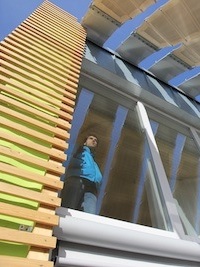Most consider the architecture of housing to be hard, fixed and permanent. But Sheila Kennedy, MIT professor of the practice of architecture and a founding principal of the architectural firm KVA Matx, has a different idea. Kennedy and her team won first place in the International Building Exhibition (IBA) design competition for their “Soft House,” which opened for public viewing this weekend as part of a 21st-century model for sustainable urban development in Germany.
“Architecture is a vehicle to bring new ideas to our culture.” Kennedy says. “Urban housing and cities need to become more enduring and resilient, responding to changes over time.”
The Soft House, a design for adaptable live/work row housing, is an example of what Kennedy calls soft architecture. The key idea, Kennedy says, is to think of energy infrastructure not as a technology that is distinct from architecture, but rather as a new set of materials with which architecture can be made.
A perfect example is the building’s flexible energy-harvesting façade — technology developed with the help of a grant from the MIT Energy Initiative. Made of a network of textile strips integrated with photovoltaic cells, the façade is a responsive two axis solar tracking system. Just as a sunflower moves with the sun, the façade moves to capture the maximum amount of clean energy to power the housing units. At the same time, it casts shade in the summer and allows light to penetrate deep into the homes during the winter — saving the household energy year round. As it changes position, the responsive façade creates different shade patterns and views that become part of the architecture.

The Soft House façade demonstrates how historically “hard” energy infrastructure — such as nonrenewable energy, glass-based solar panels and sun-tracking machinery — can be transformed by design that uses soft, lighter-weight, low-carbon materials linked by energy and information networks.
With its solid soft-wood structure and movable soft layers, the Soft House transforms the thick, opaque perimeter walls used in German Passivehaus buildings and creates instead an open and flexible living space that meets Passivehaus environmental standards.
“We need to have the conceptual flexibility and creativity to see where the new materials can take us,” Kennedy says. “The most interesting applications for new materials are those that work at many levels. If we can demonstrate these ideas, we can get them out into the marketplace — where they can start doing good in the world.”
The Soft House joins a sustainable, model community built on Wilhelmsburg Island in Germany’s River Elbe. There, about 74 acres of new housing, work and leisure space will be monitored, visited and ultimately occupied. If the real-world implementation goes as planned, the Soft House project can be replicated as a model for conditions anywhere in the world.
“The real impact and excitement of the Soft House comes with the idea of what can happen with this new model going forward,” Kennedy says.
Learn more about the Soft House at IBA Hamburg.